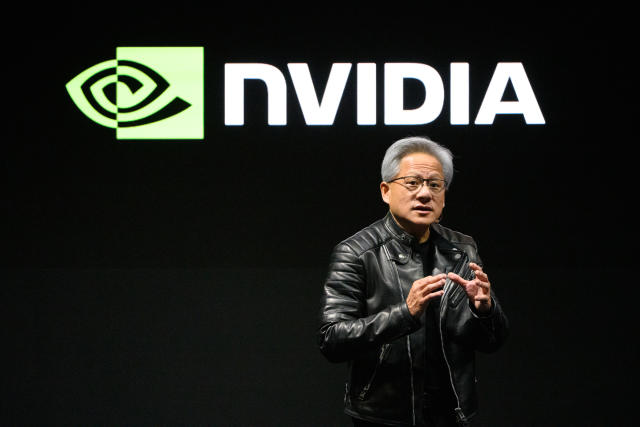NVIDIA advances AI frontiers with CES 2025 announcements
NVIDIA CEO and founder Jensen Huang took the stage for a keynote at CES 2025 to outline the company’s vision for the future of AI in gaming, autonomous vehicles (AVs), robotics, and more.
“AI has been advancing at an incredible pace,” Huang said. “It started with perception AI — understanding images, words, and sounds. Then generative AI — creating text, images, and sound. Now, we’re entering the era of ‘physical AI,’ AI that can perceive, reason, plan, and act.”
With NVIDIA’s platforms and GPUs at the core, Huang explained how the company continues to fuel breakthroughs across multiple industries while unveiling innovations such as the Cosmos platform, next-gen GeForce RTX 50 Series GPUs, and compact AI supercomputer Project DIGITS.
RTX 50 series: “The GPU is a beast”
One of the most significant announcements during CES 2025 was the introduction of the GeForce RTX 50 Series, powered by NVIDIA Blackwell architecture. Huang debuted the flagship RTX 5090 GPU, boasting 92 billion transistors and achieving an impressive 3,352 trillion AI operations per second (TOPS).
Other advancements, such as RTX Neural Shaders and RTX Mega Geometry, promise heightened realism in video games, including precise face and hair rendering using generative AI.
“GeForce enabled AI to reach the masses, and now AI is coming home to GeForce,” said Huang.
Holding the blacked-out GPU, Huang called it “a beast,” highlighting its advanced features, including dual cooling fans and its ability to leverage AI for revolutionary real-time graphics.
Set for a staggered release in early 2025, the RTX 50 Series includes the flagship RTX 5090 and RTX 5080 (available 30 January), followed by the RTX 5070 Ti and RTX 5070 (February). Laptop GPUs join the lineup in March.
In addition, NVIDIA introduced DLSS 4 – featuring ‘Multi-Frame Generation’ technology – which boosts gaming performance up to eightfold by generating three additional frames for every frame rendered.
Cosmos: Ushering in physical AI

NVIDIA also unveiled new AI foundation models for RTX PCs, which aim to supercharge content creation, productivity, and enterprise applications. These models, presented as NVIDIA NIM (Neural Interaction Model) microservices, are designed to integrate with the RTX 50 Series hardware.
Huang emphasised the accessibility of these tools: “These AI models run in every single cloud because NVIDIA GPUs are now available in every cloud.”
NVIDIA is doubling down on its push to equip developers with advanced tools for building AI-driven solutions. The company introduced AI Blueprints: pre-configured tools for crafting agents tailored to specific enterprise needs, such as content generation, fraud detection, and video management.
“They are completely open source, so you could take it and modify the blueprints,” explains Huang.
Huang also announced the release of Llama Nemotron, designed for developers to build and deploy powerful AI agents.
Ahmad Al-Dahle, VP and Head of GenAI at Meta, said: “Agentic AI is the next frontier of AI development, and delivering on this opportunity requires full-stack optimisation across a system of LLMs to deliver efficient, accurate AI agents.
“Through our collaboration with NVIDIA and our shared commitment to open models, the NVIDIA Llama Nemotron family built on Llama can help enterprises quickly create their own custom AI agents.”
Philipp Herzig, Chief AI Officer at SAP, added: “AI agents that collaborate to solve complex tasks across multiple lines of the business will unlock a whole new level of enterprise productivity beyond today’s generative AI scenarios.
“Through SAP’s Joule, hundreds of millions of enterprise users will interact with these agents to accomplish their goals faster than ever before. NVIDIA’s new open Llama Nemotron model family will foster the development of multiple specialised AI agents to transform business processes.”
Project DIGITS: Compact AI supercomputer
Huang concluded his NVIDIA keynote at CES 2025 with a final “one more thing” announcement: Project DIGITS, NVIDIA’s smallest yet most powerful AI supercomputer, powered by the cutting-edge GB10 Grace Blackwell Superchip.
“This is NVIDIA’s latest AI supercomputer,” Huang declared, revealing its compact size, claiming it’s portable enough to “practically fit in a pocket.”
Project DIGITS enables developers and engineers to train and deploy AI models directly from their desks, providing the full power of NVIDIA’s AI stack in a compact form.

Vision for tomorrow
Reflecting on NVIDIA’s journey since inventing the programmable GPU in 1999, Huang described the past 12 years of AI-driven change as transformative.
“Every single layer of the technology stack has been fundamentally transformed,” he said.
With advancements spanning gaming, AI-driven agents, robotics, and autonomous vehicles, Huang foresees an exciting future.
“All of the enabling technologies I’ve talked about today will lead to surprising breakthroughs in general robotics and AI over the coming years,” Huang concludes.


